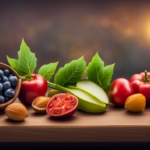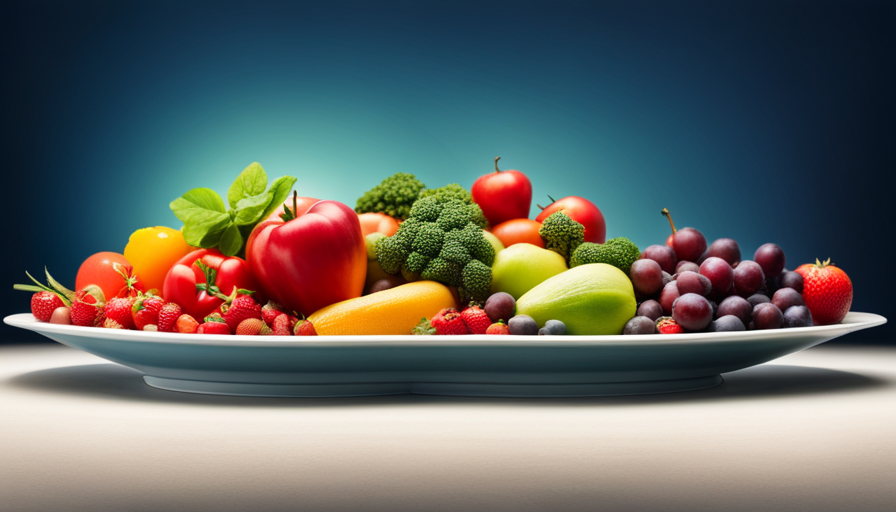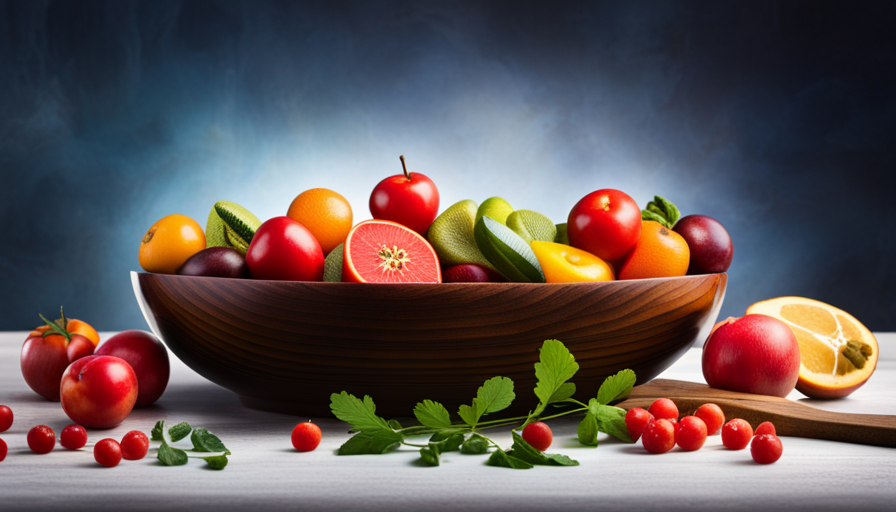So, you’re interested in learning how to follow a raw food diet, right? Let me assure you, it’s not as extreme as it may seem. In fact, it could be the secret to improving your health and energy levels.
The raw food diet is all about eating foods in their most natural, uncooked state, and let me tell you, it’s packed with benefits. Not only can it help you lose weight and increase your energy levels, but it can also improve digestion, boost your immune system, and even slow down the aging process.
But where do you start? What foods should you be eating? Don’t worry, I’ve got you covered. In this article, we’ll explore the ins and outs of the raw food diet, including the types of foods you should include, success stories from real-life people, and resources to help you along the way.
Let’s dive in and discover the power of raw food together!
Key Takeaways
- Start transitioning to a raw food diet gradually, incorporating more raw fruits and vegetables into your meals.
- Seek support and guidance from online communities or local raw food groups to help with the transition and share recipes and tips.
- Aim to replace one cooked meal per day with a raw salad or smoothie, and gradually increase to two or three raw meals per day.
- Pay attention to your body’s signals, adjusting your diet based on energy levels, digestion, and overall well-being. Experiment with different foods and meal combinations to find what works best for you.
What is a Raw Food Diet?
A Raw Food Diet is a fantastic way to nourish your body with vibrant, living foods that can transform your health and ignite a fiery passion for life! It involves consuming uncooked, unprocessed foods such as fruits, vegetables, nuts, seeds, and sprouted grains.
By eating these foods in their natural state, you provide your body with essential nutrients, enzymes, and antioxidants that can promote optimal health and well-being.
One of the main benefits of a raw food diet is weight loss. Raw foods are typically low in calories and high in fiber, which can help you feel full and satisfied while consuming fewer calories. Additionally, raw foods are often nutrient-dense, meaning they provide a high amount of essential nutrients per calorie. This can support weight loss by ensuring your body gets the nutrients it needs without excess calories.
Incorporating a raw food diet into your lifestyle can also have numerous other benefits, such as increased energy levels, improved digestion, clearer skin, and enhanced mental clarity. These benefits can stem from the abundance of vitamins, minerals, and phytochemicals found in raw foods, as well as the elimination of processed foods that may contain additives and preservatives.
Transitioning to a raw food diet may seem daunting at first, but with proper planning and education, it can be a rewarding and transformative experience.
In the next section, we will explore the specific benefits of a raw food diet and how it can improve your overall well-being.
Benefits of a Raw Food Diet
One enticing aspect of embracing a raw food lifestyle is the vibrant explosion of colors found in a plateful of nature’s bounty. Not only does a raw food diet offer a stunning visual appeal, but it also provides numerous health benefits. Research has shown that a raw food diet can aid in weight loss and promote overall well-being.
Here are some of the benefits of a raw food diet:
-
Weight Loss: Raw foods are typically low in calories and high in fiber, making them an excellent choice for those looking to shed extra pounds. The high water content in raw fruits and vegetables also helps to keep you feeling full and satisfied.
-
Increased Nutrient Intake: Raw foods are packed with essential nutrients, including vitamins, minerals, and antioxidants. These nutrients are often lost during cooking, so consuming them in their raw state ensures maximum nutritional value.
-
Improved Digestion: Raw foods are rich in enzymes, which aid in the digestion process. These enzymes help break down food and improve nutrient absorption, leading to better digestion and gut health.
By incorporating a variety of raw foods into your diet, you can experience these benefits and more. In the next section, we will explore the types of raw foods to include and how to incorporate them into your daily meals.
Types of Raw Foods to Include
Get ready to explore an array of tantalizing options for your plate as we delve into the different types of delectable raw foods you can include in your daily meals. Incorporating a variety of raw foods into your diet can provide numerous health benefits and add a burst of flavor to your meals.
One type of raw food recipe that you can enjoy is a refreshing salad. By combining crisp lettuce, juicy tomatoes, crunchy cucumbers, and other vibrant vegetables, you can create a colorful and nutrient-rich dish. Salads aren’t just delicious, but they’re also a great way to increase your intake of vitamins, minerals, and fiber.
Another option is to include raw fruits in your diet. Fruits like berries, apples, and oranges are packed with antioxidants, vitamins, and natural sugars. They can be enjoyed as a snack, added to smoothies, or even used to make a delicious fruit salad.
Including raw foods in your diet can have numerous benefits. They’re rich in vitamins, minerals, and enzymes that aid in digestion and promote overall health. Raw foods also tend to be lower in calories and higher in fiber, making them a great addition to a weight-loss or weight-maintenance plan.
Transitioning to the next section about fruits and vegetables, let’s dive into the wide variety of options available for incorporating these nutritious delights into your raw food diet.
a. Fruits and Vegetables
Explore the vibrant world of fruits and vegetables, and let these nutrient-packed delights be your gateway to a healthier, more flavorful lifestyle. When it comes to a raw food diet, fruits and vegetables are the stars of the show. They’re rich in essential vitamins, minerals, and antioxidants that can boost your immune system, improve digestion, and promote overall well-being.
When choosing fruits for a raw food diet, it’s best to opt for those that are ripe, fresh, and in season. Some of the top fruits to include are berries, such as strawberries, blueberries, and raspberries, which are packed with antioxidants.
Citrus fruits like oranges, grapefruits, and lemons are also excellent choices as they’re high in vitamin C and can help cleanse the body. Other fruits like apples, bananas, and melons provide a good source of fiber and natural sugars to keep you energized throughout the day.
Vegetables are equally important in a raw food diet. Leafy greens like spinach, kale, and lettuce are nutrient powerhouses, packed with vitamins A, C, and K, as well as iron and calcium. Cruciferous vegetables like broccoli, cauliflower, and Brussels sprouts are also great choices as they contain cancer-fighting compounds and are low in calories.
Additionally, colorful vegetables like bell peppers, carrots, and tomatoes provide a variety of vitamins and minerals to support optimal health.
Now, let’s transition into the next section about ‘b. nuts and seeds’ and discover the incredible benefits they hold for a raw food diet.
b. Nuts and Seeds
Nuts and seeds, with their abundance of essential fatty acids, vitamins, and minerals, offer a nourishing and satisfying addition to a balanced, plant-based eating plan. These small powerhouses of nutrition provide a wide range of health benefits.
Almonds, for example, are packed with vitamin E, magnesium, and fiber, while walnuts are rich in omega-3 fatty acids. Cashews are a great source of iron and zinc, and pumpkin seeds are high in protein and antioxidants.
Incorporating a variety of nuts and seeds into your raw food diet can help ensure you receive all the essential nutrients your body needs.
When including nuts and seeds in your raw food diet, it’s important to be mindful of portion sizes. While they are nutrient-dense, they are also high in calories, so moderation is key. A recommended serving size is about a handful or 1-2 ounces per day.
You can enjoy them as a snack on their own or add them to salads, smoothies, or raw desserts for an extra boost of flavor and nutrition.
Now, let’s move on to the next section about ‘c. sprouts and fermented foods’ to explore more delicious and beneficial options for your raw food diet.
c. Sprouts and Fermented Foods
Sprouts and fermented foods are an exciting and flavorful addition to any plant-based eating plan, offering a range of health benefits and delicious options for your meals.
Sprouts, such as alfalfa, broccoli, and mung bean sprouts, are packed with vitamins, minerals, and enzymes that support digestion and boost immunity. They’re also low in calories and high in fiber, making them a great choice for weight management. Adding sprouts to salads, sandwiches, or wraps can bring a fresh and crunchy texture to your dishes.
On the other hand, fermented foods like sauerkraut, kimchi, and kombucha are rich in probiotics, which are beneficial bacteria that support gut health. These foods undergo a natural fermentation process, which enhances their flavors and increases their nutritional value. Fermented foods can improve digestion, strengthen the immune system, and even enhance mood and mental health.
To incorporate sprouts and fermented foods into your raw food diet, you can try making a delicious sprout salad with mixed greens, sprouts, and your favorite raw vegetables. For fermented foods, you can experiment with homemade sauerkraut or try different fermented vegetable recipes available online.
Transitioning to a raw food diet doesn’t have to be overwhelming. By gradually incorporating more raw fruits, vegetables, sprouts, and fermented foods into your meals, you can experience the benefits and flavors of this nutritious way of eating.
How to Transition to a Raw Food Diet
Transitioning to a raw food lifestyle can be a journey of discovering vibrant flavors and nourishing your body with whole, unprocessed goodness. If you’re considering making the switch, here are some transitioning tips to help you get started:
-
Start gradually: It’s important to ease into a raw food diet to allow your body to adjust. Begin by incorporating more raw fruits and vegetables into your meals and gradually reduce the amount of cooked foods you consume.
-
Experiment with raw food recipes: Finding delicious and satisfying raw food recipes will make your transition easier. Look for recipes that use simple and fresh ingredients, such as smoothies, salads, and raw desserts. There are plenty of resources available online and in cookbooks to help you explore different options.
-
Seek support and guidance: Transitioning to a raw food diet can be challenging, so it’s helpful to connect with others who are on a similar journey. Join online communities or find local raw food groups where you can share experiences, ask questions, and get advice.
By following these transitioning tips and exploring different raw food recipes, you can gradually incorporate more raw foods into your diet and experience the benefits of this nourishing lifestyle.
Now, let’s take a closer look at the first step: starting gradually.
a. Start Gradually
To ease into a raw food lifestyle, it’s important to gradually incorporate more fresh and unprocessed fruits and vegetables into your meals, allowing your body to adjust and discover the vibrant flavors of this nourishing journey. Transitioning to a raw food diet can be challenging, but taking it gradually can help you overcome potential obstacles and make the process more sustainable.
One way to start the transition is by adding a raw element to each meal. For example, you can have a side of fresh sliced tomatoes or a handful of raw nuts alongside your regular cooked meals. This gradual approach allows your taste buds to adapt to the flavors and textures of raw foods while still enjoying your favorite cooked dishes.
Another strategy is to gradually replace cooked foods with raw alternatives. Start by swapping one cooked meal a day with a raw salad or a smoothie. As you become more comfortable and experienced with raw food preparation, you can increase the number of raw meals in your daily routine.
To help you visualize the process, here’s a table that outlines a gradual transition plan:
| Week | Transition Plan |
|---|---|
| 1 | Add raw fruits or vegetables as a side dish to one meal each day |
| 2 | Replace one cooked meal with a raw salad or smoothie |
| 3 | Have two raw meals per day |
| 4 | Aim for three raw meals per day |
By following this gradual transition plan, you can overcome potential challenges and make the process more manageable. With time, you’ll become more confident in experimenting with raw recipes and incorporating them into your daily meals. So, let’s move on to the next section and explore how to experiment with raw recipes.
b. Experiment with Raw Recipes
Try experimenting with different raw recipes to discover new flavors and textures that can enhance your meals. One delicious option is to create a refreshing and tangy zucchini noodle salad with a homemade lemon dressing. The combination of crisp zucchini noodles and zesty lemon dressing creates a light and flavorful dish that’s perfect for a raw food diet.
To help you enjoy your raw food journey, here are three tips to keep in mind:
-
Experiment with flavor combinations: Don’t be afraid to mix and match different fruits, vegetables, herbs, and spices. For example, try adding fresh mint leaves to your watermelon salad or adding a pinch of cayenne pepper to your avocado dip. The possibilities are endless, so have fun and get creative!
-
Try different kitchen gadgets: Investing in a few helpful tools can make your raw food experience even more enjoyable. Consider getting a spiralizer to make noodle-like strands out of vegetables like zucchini or carrots. You could also try a high-speed blender for creating creamy smoothies or a dehydrator for making delicious raw snacks like kale chips.
-
Stay hydrated: Drinking enough water is essential for any diet, including a raw food diet. Make sure to drink plenty of water throughout the day to keep your body hydrated and support digestion. Additionally, you can incorporate hydrating foods like cucumber, watermelon, and lettuce into your meals to increase your water intake.
By experimenting with different raw recipes and trying out new flavor combinations, you can truly make your raw food diet an exciting and delicious adventure. Next, let’s explore the importance of staying hydrated on a raw food diet.
c. Stay Hydrated
Ensuring proper hydration is crucial for maintaining optimal health and well-being while following a raw food lifestyle. Staying hydrated is especially important because raw foods have a high water content, which can help replenish fluids in the body. Hydration plays a key role in digestion, nutrient absorption, and waste removal, all of which are essential for overall health.
One of the benefits of hydration on a raw food diet is improved digestion. Raw foods are rich in fiber, which requires water to move smoothly through the digestive tract. This can prevent constipation and promote regular bowel movements. Additionally, staying hydrated can help prevent dehydration, which can lead to fatigue, headaches, and difficulty concentrating.
To stay hydrated on a raw food diet, it’s important to drink plenty of water throughout the day. Aim for at least eight glasses of water, and more if you’re physically active or live in a hot climate. You can also increase your water intake by consuming hydrating raw fruits and vegetables like watermelon, cucumber, and celery.
Staying hydrated is essential for maintaining optimal health while following a raw food diet. Proper hydration supports digestion, nutrient absorption, and waste removal. By drinking enough water and consuming hydrating raw foods, you can reap the benefits of hydration on your raw food journey.
Now, let’s explore potential challenges and how to overcome them.
Potential Challenges and How to Overcome Them
Overcoming potential challenges on your raw food journey can be a transformative experience, allowing you to discover inner strength and resilience.
One of the challenges you may encounter is dealing with social situations and eating out. It can be challenging to stick to a raw food diet when you are surrounded by friends or family members who do not follow the same dietary choices. To overcome this challenge, it’s important to communicate your needs and preferences to your loved ones. Let them know why you’ve chosen a raw food diet and ask for their support. Additionally, you can suggest alternative dining options that cater to raw food or bring your own dishes to social gatherings.
Another challenge you may face on a raw food diet is dealing with cravings. It’s natural to crave certain foods, especially if you’ve been accustomed to a different way of eating. To overcome cravings, it’s important to have a variety of raw food options available at all times. This will help satisfy your taste buds and prevent you from reaching for unhealthy alternatives. Additionally, finding new and exciting raw food recipes can help keep your meals interesting and enjoyable.
Transitioning into the subsequent section about social situations and eating out, it’s important to be prepared and proactive when faced with these challenges. By planning ahead and having strategies in place, you can navigate these situations with ease and continue on your raw food journey.
a. Social Situations and Eating Out
Navigating social situations and dining out can be a piece of cake if you arm yourself with a game plan and embrace the saying ‘when in Rome, do as the Romans do.’
When it comes to socializing challenges on a raw food diet, communication is key. Let your friends and family know about your dietary preferences and explain the reasons behind your choice. This will help them understand and support you.
When dining out, it’s important to research and find restaurants that offer raw food options. Many cities now have vegan or vegetarian establishments that cater to raw foodists. Additionally, some mainstream restaurants may have raw food options on their menus. Don’t be afraid to ask the waiter or chef for modifications to suit your needs.
If you’re attending a social gathering or potluck, bring your own raw food dish to share with others. This way, you’ll have something you can enjoy while also introducing others to the deliciousness of raw food.
Transitioning into the subsequent section about nutrient deficiencies, it’s important to be aware of the potential challenges of obtaining all the necessary nutrients on a raw food diet.
b. Nutrient Deficiencies
When it comes to following a raw food diet, there are a few important considerations to keep in mind. In the previous subtopic, we discussed how to navigate social situations and eating out while sticking to a raw food diet.
Now, let’s talk about another crucial aspect: nutrient deficiencies. While a raw food diet can offer many health benefits, it’s important to be aware of potential nutrient deficiencies that may arise. Since this diet eliminates certain food groups like dairy, meat, and grains, it can be challenging to obtain all the necessary nutrients for optimal health.
To ensure you’re getting everything your body needs, here are three key nutrients to focus on:
-
Protein: Incorporate plant-based sources of protein such as nuts, seeds, legumes, and leafy greens.
-
Calcium: Include calcium-rich foods like kale, broccoli, almonds, and chia seeds in your diet.
-
Vitamin B12: Since this vitamin is primarily found in animal products, consider taking a B12 supplement or consuming fortified foods like nutritional yeast or plant-based milks.
It’s important to note that nutrient deficiencies can lead to various health risks. Therefore, it’s crucial to monitor your nutrient intake and consider working with a registered dietitian or nutritionist to ensure you’re meeting your body’s needs on a raw food diet.
Now, let’s move on to the next section and discuss an equally important topic: food safety.
c. Food Safety
Ensuring the safety of what I eat is essential for my well-being and peace of mind. When following a raw food diet, it’s important to be aware of food safety guidelines to minimize potential risks.
Raw foods, especially fruits and vegetables, can harbor harmful bacteria like E. coli and Salmonella. To reduce the risk of contamination, it’s crucial to wash all produce thoroughly before consuming it. I make sure to use clean water and a scrub brush to remove any dirt or bacteria from the surface.
Additionally, I pay close attention to the freshness of the ingredients I use. Spoiled or rotten foods can contain harmful pathogens that can lead to foodborne illnesses. I always check for any signs of spoilage, such as mold or an unpleasant odor, before including them in my meals.
Proper storage is also key in maintaining food safety. I store perishable raw foods, such as sprouts and leafy greens, in the refrigerator at temperatures below 40°F (4°C). This helps to slow down the growth of bacteria and keep the food fresh for longer.
By following these food safety guidelines, I can enjoy the benefits of a raw food diet while minimizing the potential risks.
Now let’s move on to some tips for meal planning and preparation, which will help me stay organized and make the most out of my raw food journey.
Tips for Meal Planning and Preparation
One interesting statistic to consider is that individuals who plan and prepare their meals in advance are more likely to consume a greater variety of fruits and vegetables. Meal planning and preparation can be a game-changer when it comes to following a raw food diet. Here are some meal prep tips to help you on your journey.
Firstly, set aside some time each week to plan your meals and create a shopping list. This will ensure that you have all the necessary ingredients on hand and reduce the temptation to deviate from your raw food plan. It’s also helpful to batch cook and store meals in individual portions, making it easy to grab and go when you’re in a hurry.
Another tip is to experiment with different recipes and flavors. By trying new dishes, you can keep things interesting and prevent boredom with your raw food diet. Consider incorporating a variety of fruits, vegetables, nuts, and seeds to ensure you’re getting a wide range of nutrients.
In addition to variety, meal planning allows you to ensure a balanced diet. By strategically planning your meals, you can ensure that you’re getting all the necessary nutrients your body needs. This can help prevent deficiencies and keep you feeling energized.
Meal planning and preparation are key components of a successful raw food diet. By taking the time to plan your meals, you can increase your consumption of fruits and vegetables, experiment with new recipes, and ensure a balanced diet. These meal prep tips will set you on the right path to success in your raw food journey.
Now, let’s move on to stocking your kitchen with raw food essentials.
a. Stocking Your Kitchen with Raw Food Essentials
Now that we’ve covered some helpful tips for meal planning and preparation, let’s move on to the next step in starting a raw food diet: stocking your kitchen with raw food essentials. Having the right tools and ingredients on hand is crucial for success in this lifestyle.
To begin, here are some key items you’ll want to have in your kitchen:
- High-Speed Blender: A powerful blender is essential for making smoothies, sauces, and dressings.
- Food Processor: This versatile tool is great for chopping, shredding, and making raw desserts.
- Dehydrator: While not necessary, a dehydrator can be useful for making raw snacks like kale chips or fruit leather.
- Spiralizer: This handy gadget allows you to create noodles from vegetables like zucchini or carrots, adding variety to your meals.
- Nut Milk Bag: Perfect for making homemade nut milks, this bag helps to strain out any pulp or solids.
Having these tools readily available will make it easier to incorporate raw foods into your daily routine. So, gather these essentials and get ready to embark on your raw food journey!
Now, let’s move on to the next topic: batch cooking and meal prepping.
b. Batch Cooking and Meal Prepping
To make your transition to a raw food lifestyle seamless, let’s dive into the art of batch cooking and meal prepping. These two techniques are essential for saving time and ensuring you always have nutritious meals on hand.
When it comes to batch cooking, the key is to prepare large quantities of food at once. You can start by making a big batch of raw soups, salads, or dressings and then portion them into individual servings. Store them in airtight containers in the refrigerator or freezer for easy access throughout the week.
Meal prepping guidelines are equally important. Start by planning your meals for the week and making a shopping list. This will help you stay organized and ensure you have all the necessary ingredients on hand. When prepping your meals, focus on chopping and cleaning fruits and vegetables, making nut or seed milks, or soaking grains and legumes. By doing these tasks ahead of time, you’ll save yourself valuable minutes during the week.
By incorporating batch cooking and meal prepping into your raw food routine, you’ll be able to streamline your meal preparation process and ensure you always have delicious, healthy options available.
Now, let’s explore how to incorporate variety and creativity into your meals.
c. Incorporating Variety and Creativity into Your Meals
Adding variety and creativity to your meals is essential for keeping your raw food lifestyle exciting and enjoyable. Not only does it prevent boredom and monotony, but it also ensures that you’re getting a wide range of nutrients from different fruits, vegetables, nuts, and seeds.
The benefits of incorporating variety into your meals are numerous. Different foods contain different vitamins, minerals, and antioxidants that are essential for overall health and well-being. By eating a diverse range of raw foods, you can optimize your nutrient intake and support your body’s natural detoxification processes.
To add variety to your raw food diet, you can experiment with different fruits and vegetables that are in season. This not only ensures freshness and flavor but also allows you to support local farmers and reduce your carbon footprint. Additionally, try incorporating different textures into your meals by using a variety of nuts, seeds, and sprouts. For example, you can add crunchiness with almonds or sunflower seeds, or add creaminess with avocado or coconut meat.
Being creative with your meal ideas is also important to keep your raw food diet interesting. You can experiment with different flavor combinations, herbs, and spices to enhance the taste of your dishes. For example, you can make a zucchini noodle salad with a tangy lemon dressing or create a delicious raw chocolate mousse using avocados and cacao powder.
Adding variety and creativity to your raw food meals is crucial for a fulfilling and enjoyable experience. By incorporating a wide range of fruits, vegetables, nuts, and seeds, you can ensure optimal nutrient intake and support your body’s natural detoxification processes.
Stay tuned for the next section on listening to your body and adjusting your diet.
Listening to Your Body and Adjusting Your Diet
OUTPUT:
LISTEN TO YOUR BODY AND ADJUST YOUR DIET:
Take a moment to connect with how you feel after each meal – your body will guide you towards what it truly needs. Listening to your body is essential when following a raw food diet.
Pay attention to any changes in energy levels, digestion, and overall well-being. These cues can help you determine if your current diet is meeting your nutritional needs.
Adjusting your diet based on your body’s signals is an ongoing process. Your body may require different nutrients at different times, depending on factors such as activity level, stress, and seasonal changes.
If you feel sluggish or experience digestive issues, it may be a sign that you need to incorporate more variety into your meals or consider adding certain foods that provide missing nutrients.
Keep in mind that everyone’s body is unique, and what works for one person may not work for another. Experiment with different foods and meal combinations to find what suits you best. It’s important to consult with a healthcare professional or registered dietitian if you have any specific health concerns or dietary restrictions.
By listening to your body and adjusting your diet accordingly, you can optimize your raw food journey and ensure you’re getting the nutrients you need.
In the next section, we’ll address common misconceptions about raw food diets without compromising your health.
Common Misconceptions about Raw Food Diets
Don’t fall for the misconceptions about raw food diets – they’re as misleading as a mirage in the desert. People often have common misconceptions about raw food diets, but it’s important to separate fact from fiction. Let’s take a closer look at some of the most common misconceptions and challenges faced on a raw food diet.
| Misconception | Reality |
|---|---|
| Raw food diets lack nutrients | Raw food diets can provide all the necessary nutrients if properly planned and varied. It’s important to include a wide range of fruits, vegetables, nuts, and seeds to ensure you’re getting enough essential vitamins, minerals, and antioxidants. |
| Raw food diets are difficult to follow | While transitioning to a raw food diet can be challenging, with proper planning and preparation, it can become a sustainable lifestyle. Experiment with different recipes, meal plans, and food preparation techniques to find what works best for you. |
| Raw food diets lack protein | Contrary to popular belief, raw food diets can provide sufficient protein through sources like nuts, seeds, sprouts, and leafy greens. Combining different plant-based protein sources ensures you’re meeting your protein needs. |
Understanding these misconceptions and challenges can help you navigate a raw food diet more effectively. However, one common challenge that people face on a raw food diet is the concern about a lack of protein and nutrients.
a. Lack of Protein and Nutrients
Navigating a raw food lifestyle can feel like traversing a wide desert landscape, with one common concern being the challenge of ensuring you consume enough protein and essential nutrients. However, it’s a misconception that a raw food diet lacks protein and nutrients. Here are four key points to consider:
-
Plant-based protein sources: Raw food diets can provide ample protein through various plant-based sources such as nuts, seeds, legumes, and leafy greens. Incorporating a variety of these foods in your meals can help meet your protein needs.
-
Nutrient-dense fruits and vegetables: Raw food diets emphasize the consumption of fresh fruits and vegetables, which are rich in essential vitamins, minerals, and antioxidants. These nutrient-dense foods can help prevent nutrient deficiencies.
-
Sprouting and fermenting: Sprouting and fermenting grains, seeds, and legumes can enhance their nutritional value by increasing the bioavailability of nutrients. These techniques also help in breaking down anti-nutrients, making the nutrients more accessible for absorption.
-
Supplementation if necessary: If you have specific nutrient requirements or concerns, it’s advisable to consult a healthcare professional or registered dietitian who can guide you on appropriate supplementation.
Despite the misconceptions, a well-planned raw food diet can provide sufficient protein and essential nutrients. However, another challenge faced in this lifestyle is the difficulty in meeting caloric needs.
b. Difficulty in Meeting Caloric Needs
When it comes to following a raw food diet, there are several challenges that one may face. In my previous discussion, I highlighted the lack of protein and nutrients as a potential concern. However, another important aspect to consider is the difficulty in meeting caloric needs.
Raw food diets primarily consist of fruits, vegetables, nuts, and seeds, which are generally low in calories compared to processed foods. This means that it can be challenging to consume enough calories to meet your daily energy requirements. It’s crucial to ensure that you’re getting enough calories from nutrient-dense sources to avoid feeling fatigued or experiencing a decline in overall health.
To meet nutritional requirements and manage cravings on a raw food diet, it’s important to incorporate a variety of foods that are high in healthy fats and proteins. Avocados, nuts, seeds, and legumes can be excellent sources of these essential nutrients. Additionally, including nutrient-dense fruits and vegetables like bananas, sweet potatoes, and leafy greens can help meet your caloric needs while providing a wide range of vitamins and minerals.
By carefully selecting a diverse range of raw food options, you can successfully meet your nutritional requirements and manage cravings. Transitioning into the next section about taste and satisfaction, it’s important to find ways to make your raw food meals enjoyable and satisfying without compromising the principles of the diet.
c. Taste and Satisfaction
One key aspect to consider in the realm of taste and satisfaction on a raw food regimen is finding creative ways to enhance the flavors and textures of your meals while still adhering to the principles of the diet.
Taste preferences play a significant role in our overall meal satisfaction, and it can be challenging to adjust to the flavors of raw foods initially. However, there are numerous techniques you can use to make your meals more enjoyable.
First, experiment with different seasonings and spices to add depth and complexity to your dishes. Fresh herbs like basil, cilantro, and mint can bring a burst of flavor to salads or raw soups. Additionally, using citrus juices, such as lemon or lime, can provide a tangy kick to your meals.
Another way to increase satisfaction is by incorporating different textures into your meals. Adding crunchy vegetables like bell peppers or cucumbers to a salad can provide a satisfying crunch. You can also experiment with different methods of preparing your food, such as marinating, dehydrating, or blending, to create diverse textures and flavors.
By understanding your taste preferences and getting creative in the kitchen, you can make your raw food meals more enjoyable and satisfying. Transitioning to a raw food diet may seem challenging at first, but with time, you’ll discover new recipes and combinations that excite your taste buds.
Moving on to success stories and inspiration, many individuals have found great joy and health benefits from following a raw food diet.
Success Stories and Inspiration
Explore the incredible transformations and stories of individuals who have embraced the power of a raw food lifestyle, inspiring you to embark on your own journey towards vitality and well-being. Success stories can be incredibly motivating and inspiring when it comes to adopting a raw food diet. Hearing about real people who have achieved remarkable health improvements through this lifestyle can give you the confidence and motivation to make a change in your own life.
To illustrate the power of a raw food diet, here are some inspiring stories of individuals who have experienced incredible transformations:
| Name | Health Condition Improved |
|---|---|
| Sarah | Weight loss, increased energy |
| John | Lowered cholesterol levels |
| Emily | Improved digestion |
| Michael | Clearer skin, reduced inflammation |
These success stories serve as a reminder that a raw food diet can have a profound impact on our health and well-being. They show that with dedication and commitment, it is possible to achieve significant improvements in various areas of our health.
As you read these stories, you’ll likely find yourself feeling inspired and motivated to explore the benefits of a raw food diet for yourself. In the next section, we will dive deeper into real-life stories of health transformation, providing you with even more evidence and motivation to embark on your own raw food journey.
a. Real-life Stories of Health Transformation
Immersing oneself in the inspiring narratives of individuals who’ve undergone remarkable health transformations can ignite a vivid mental picture of the power and potential of embracing a lifestyle centered around nourishing, unprocessed sustenance.
Real-life stories of health transformation provide concrete evidence of the positive impact that a raw food diet can have on one’s overall well-being. These success stories often involve individuals who’ve struggled with various health issues, such as obesity, diabetes, and chronic fatigue, and have found solace and healing through the adoption of a raw food lifestyle.
Their stories serve as a testament to the transformative power of raw, unprocessed foods in reversing chronic diseases and restoring vitality. Through their journeys, we witness the incredible physical and mental changes that occur when individuals transition to a raw food diet. Weight loss, increased energy levels, improved digestion, clearer skin, and enhanced mental clarity are just a few of the benefits experienced by those who’ve embraced this lifestyle.
These real-life transformations not only inspire and motivate others to embark on their own raw food journey but also provide practical insights and strategies for success. By sharing their stories, these individuals provide guidance and support for those who’re looking to make a positive change in their health and well-being.
As we delve deeper into the world of raw food, we’ll explore not only the success stories but also the delicious raw food recipes and testimonials that can further guide and inspire us on our own path towards optimal health and wellness.
b. Raw Food Recipes and Testimonials
Indulge in the mouthwatering symphony of flavors and let the tantalizing raw food recipes take you on a culinary adventure that will leave you feeling nourished and invigorated. Transitioning to a raw food diet can seem daunting at first, but with the right recipes and support, it can be an exciting and transformative journey.
To help you get started, here are some delicious raw food recipes that have been tried and tested by individuals who have experienced incredible health transformations. These recipes not only provide a burst of flavors but also offer a myriad of health benefits. Whether you’re craving a refreshing salad, a creamy smoothie, or a decadent dessert, there is a raw food recipe out there for everyone.
To make it easier for you to explore these recipes, here is a table showcasing five mouthwatering options:
| Recipe Name | Ingredients | Preparation Time |
|---|---|---|
| Zucchini Pasta | Zucchini, tomatoes, basil, nuts | 15 minutes |
| Green Smoothie | Spinach, banana, almond milk | 5 minutes |
| Raw Chocolate | Dates, cacao powder, nuts | 20 minutes |
| Kale Salad | Kale, avocado, lemon juice | 10 minutes |
| Fruit Parfait | Mixed fruits, coconut yogurt | 5 minutes |
These recipes have been praised by individuals who have successfully adopted a raw food diet. They have experienced increased energy levels, improved digestion, and even weight loss. Their testimonials serve as inspiration and motivation to embark on this raw food journey.
As you explore these recipes and read the testimonials, you’ll find that a raw food diet is not only delicious but also a sustainable way to nourish your body. It’s important to remember that everyone’s experience may vary, so it’s essential to listen to your body and make adjustments as needed.
Now that you have an array of tantalizing recipes and inspiring testimonials, you can continue your journey toward a raw food lifestyle. In the next section, we will explore resources for further learning and support to help you on this path.
Resources for Further Learning and Support
Discover a wealth of valuable resources and supportive communities to enhance your knowledge and journey toward a nourishing and transformative lifestyle. When embarking on a raw food diet, it’s important to have access to reliable information and support. Here are some resources that can help you on your journey:
-
Online Forums: Joining online forums dedicated to raw food diets can provide you with a space to connect with like-minded individuals, ask questions, and share experiences. Websites such as Raw Food Talk and Raw Food Rehab offer vibrant communities where you can find support and guidance.
-
Support Groups: Look for local raw food support groups in your area. These groups often organize events, potlucks, and workshops where you can meet others who are following a raw food lifestyle. Being part of a support group can provide you with motivation, accountability, and a sense of community.
-
Books and Cookbooks: There are numerous books and cookbooks available that can deepen your understanding of raw food nutrition and provide you with delicious recipes. Some popular titles include ‘Raw Food Made Easy’ by Jennifer Cornbleet and ‘The Raw Food Detox Diet’ by Natalia Rose.
-
Online Courses: If you’re looking for a more structured approach, online courses can provide you with comprehensive guidance on transitioning to a raw food diet. Websites like Udemy and Coursera offer courses taught by experts in the field.
By utilizing these resources, you can gain valuable knowledge, connect with others, and find the support you need to successfully navigate a raw food diet.
Frequently Asked Questions
Can I still eat cooked food while on a raw food diet?
While on a raw food diet, cooked food restrictions are typically followed. However, it’s important to understand the benefits of a raw food diet. By incorporating raw fruits, vegetables, nuts, and seeds, you provide your body with essential nutrients and enzymes that can support optimal health. Cooking food can often lead to nutrient loss, whereas raw foods retain their natural goodness.
So, while cooked food may be off-limits, the benefits of a raw food diet can greatly enhance your overall well-being.
How do I ensure I am getting all the necessary nutrients on a raw food diet?
To ensure I’m getting all the necessary nutrients on a raw food diet, I focus on ensuring nutrient balance and debunking common raw food diet myths. I make sure to include a variety of fruits, vegetables, nuts, and seeds in my meals to provide a wide range of nutrients.
I also pay attention to my protein intake by incorporating sources like sprouted grains and legumes. Additionally, I consider supplementing with vitamins B12 and D, as they may be lacking in a raw food diet.
Are there any potential food safety concerns with a raw food diet?
Potential health risks and foodborne illnesses are indeed a concern when following a raw food diet. Raw foods, especially meats, eggs, and unpasteurized dairy products, can harbor harmful bacteria such as Salmonella and E. coli.
To minimize these risks, it’s crucial to handle and prepare raw foods with care, ensuring proper cleaning, storage, and cooking temperatures. Additionally, choosing high-quality, fresh produce and regularly washing fruits and vegetables can further reduce the chances of contamination.
What are some tips for meal planning and preparation on a raw food diet?
Meal prep tips for a raw food diet involve planning and preparation. Start by making a meal plan for the week and creating a shopping list. When grocery shopping, focus on fresh fruits, vegetables, nuts, and seeds.
Preparing meals in advance can save time and ensure you have healthy options readily available. Wash, chop, and store produce to make it more convenient to use. Experiment with different recipes and techniques to keep your meals interesting and varied.
Where can I find additional resources and support for a raw food diet?
To find additional resources and support for a raw food diet, online communities and recipe books are great places to start.
Online communities provide a platform for connecting with like-minded individuals who can offer guidance and share their experiences. Websites and social media groups dedicated to raw food diets often have forums, recipes, and tips to help you navigate this lifestyle.
Additionally, recipe books specifically focused on raw food can provide inspiration and guidance for creating delicious and nutritious meals.
What are the basic principles of the raw food diet?
The raw food diet basics focus on consuming unprocessed, whole plant-based foods. This diet emphasizes eating fruits, vegetables, nuts, and seeds in their natural state to preserve their nutrients. Proponents of this diet believe that cooking destroys enzymes and nutrients, leading to better health and weight loss.
Conclusion
In conclusion, the raw food diet can be a beneficial way to improve overall health and well-being. By including a variety of fruits, vegetables, nuts, and seeds in your diet, you can provide your body with essential nutrients and enzymes.
The success stories and recipes shared by others can offer inspiration and motivation to embark on this lifestyle change. Remember to always consult with a healthcare professional before making any drastic dietary changes.
With the right resources and support, you can successfully transition to a raw food diet and reap its many benefits.

















